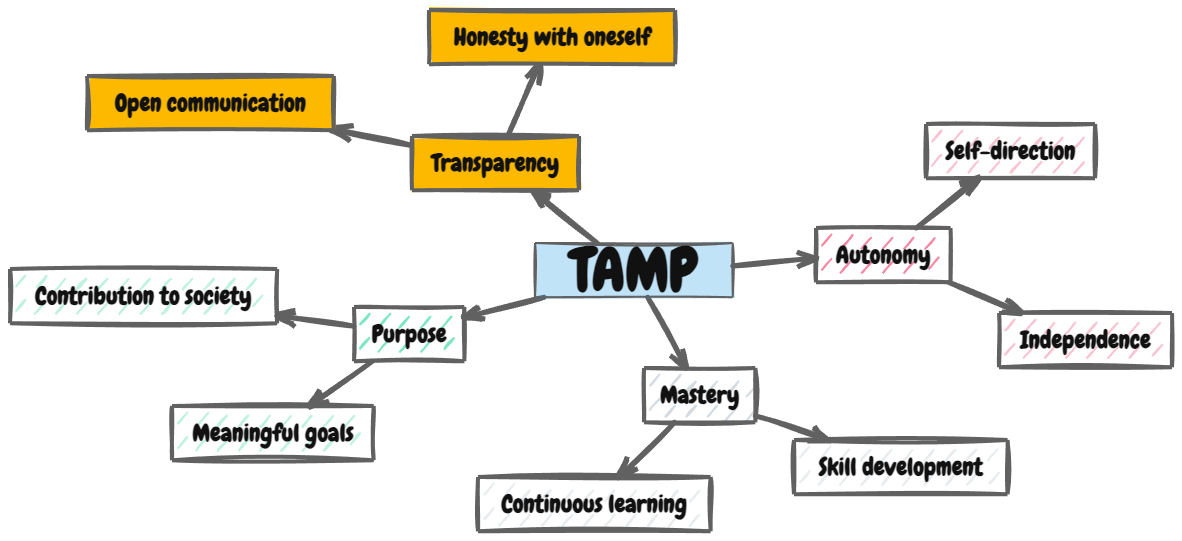In Part 1, I introduced the TAMP leadership model—Transparency, Accountability, Mastery, and Purpose. Of those, I’ve found that transparency is the most important starting point, because without it, everything else starts to wobble.
If you strip leadership down to its core, transparency is what everything else stands on.
Without it, trust erodes. Accountability falters. Purpose feels hollow. And autonomy? It turns into guesswork. Yet it’s still one of the most underused tools in a leader’s toolkit—because being transparent can feel risky. But here’s the truth: the bigger risk is staying silent.
Silence Sends a Message—It’s Just the Wrong One
Whether you say something or not, you’re still communicating.
If you’re vague, quiet, or slow to share, your team will fill in the gaps. And human nature usually leans toward the worst-case scenario:
- “Something’s wrong and they’re not telling us.”
- “Leadership doesn’t trust us.”
- “I’m not sure what we’re doing—or why.”
This isn’t about overexplaining or holding open mic night every time a new project kicks off. It’s about being clear, consistent, and honest—especially when things are hard or uncertain.
Trust doesn’t die in conflict. It dies in confusion.
Radical Transparency ≠ Oversharing
Let’s clarify something: transparency isn’t just about telling all.
It’s about being purposefully clear in ways that help your team understand context, priorities, and intent.
That means:
- Sharing what’s happening and why.
- Naming tradeoffs and explaining decisions.
- Owning when you don’t have an answer yet.
- Giving people the bad news without spin, and the good news without ego.
This kind of transparency isn’t fluffy—it’s operational. It helps people make better decisions, move faster, and stay aligned without having to constantly check the wind.
Transparency Builds More Than Trust
Yes, trust is the obvious benefit. But the ripple effects go further:
- Alignment: Everyone rows in the same direction.
- Psychological safety: People speak up and contribute more.
- Resilience: When hard things happen, people feel informed—not blindsided.
- Ownership: People take initiative because they understand the bigger picture.
And here’s a bonus: it takes pressure off you. The more your team knows, the less they depend on you for every little decision. You shift from bottleneck to enabler.
Say It Before It’s Perfect
One of the most common transparency traps is waiting until you have the whole plan nailed down before you speak up.
Don’t.
Your team doesn’t need perfect. They need real.
“Here’s what we know. Here’s what’s still unclear. Here’s what we’re trying.”
That level of honesty builds more credibility than a polished slide deck ever could.
One Final Note: People Can Handle the Truth
We underestimate this all the time.
Worried they’ll be upset? They probably will—but they’ll be even more upset if they feel misled later.
Worried they’ll lose confidence? Maybe—but you’ll gain far more respect by telling the truth early than by hiding behind delay.
Most people don’t expect perfection from leadership. They expect honesty.
They don’t need spin. They need signal.
Bottom Line
Transparency is the first move in building trust.
It doesn’t require heroic speeches—just clarity, consistency, and the willingness to show up with the truth.
Say what’s real. Say it early. Say it like it matters—because it does.
Next up in the series: Accountability and Autonomy— how to lead by owning the outcome, but still treating your team like adults, even when it’s uncomfortable.
Missed a post? Catch up on the full TAMP series: Transparency, Autonomy, Mastery, and Purpose (this post!).
Here’s the Introduction to the Concept, and a Wrap-Up of the series





One thought on “TAMP Part 2: Why Transparency is the Foundation of Real Leadership”
Comments are closed.